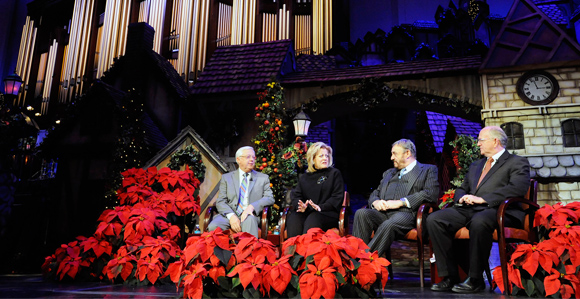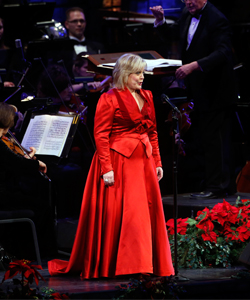Choir's Christmas Concert Features Dickens, Luke 2, and Medley
Contributed By By R. Scott Lloyd, Church News staff writer

Tabernacle Choir president Ron Jarrett, left, Deborah Voigt, John Rhys-Davies, and choir music director Mack Wilberg speak during a news conference at the LDS Conference Center auditorium stage on Friday, December 13, 2013.
Article Highlights
- American soprano Deborah Voigt joined the orchestra and choir in a medley of Christmas carols.
- A dazzling theatrical performance of “A Dickens Christmas” told the story behind the famous novel A Christmas Carol.
- British actor John Rhys-Davies read the Nativity from Luke 2, hoping the audience would feel its extraordinary significance.
“I’m really feeling very, very blessed and lucky to be here, especially at this time of year and in this environment, and I’m so grateful that they invited me.”
—Deborah Voigt, guest artist
Related Links
From a fog-enshrouded stage to an array of dancers clad in costumes of Victorian-era dress to a pair of actors floating in the air, this year’s Mormon Tabernacle Choir Christmas Concert conveyed the aura of Dickensian England.
Presented in two performances on December 13 and 14, with a public dress rehearsal on December 12, the concert featured as guest artists operatic soprano Deborah Voigt and British character actor John Rhys-Davies. The choir was supplemented by its sister organizations: the Orchestra at Temple Square and the Bells on Temple Square, combined under the direction of Mack Wilberg and Ryan Murphy.
The most dazzling and unexpected segment of this year’s show was a theatrical performance of “A Dickens Christmas” by Mr. Rhys-Davies and a company of local actors.
The guest artist portrayed the “Ghost of Christmas Present” from Charles Dickens’ famous novel A Christmas Carol. With the aid of some technical wizardry, the ghost appeared to conduct Dickens himself (actor Robin Dick) through the air above 19th-century London (actually, the audience seated on the main level of the LDS Conference Center) at night.
Based on the true story of how Dickens came to write the novel, the segment conveyed the message that the author, looking for quick earnings to make ends meet during a downturn in his writing career, created an enduring classic that has filled the hearts of millions—including Dickens himself—with the Christmas message of love and goodwill.
At a news conference the morning after the dress rehearsal, Mr. Rhys-Davies was asked about his aerial acting.
“Well, as the [Royal Air Force] used to say, a good landing is one you can walk away from,” he joked.
“I used to fly airplanes myself, so being above the ground doesn’t worry me too much. Basically, theater or film is a dangerous industrial environment. You depend … on the skills and ability of those around you to protect you. …
“And you do get that wonderful, ‘Yippee!’ sort of sensation. I think it’s great fun.” Turning to Ms. Voigt, he said, “You ought to try it sometime.”
“No, that’s OK. I’ll sing right here on the ground,” she said.
And she did just that, enthralling audiences from the moment of her appearance early in the program, singing “The Holly and the Ivy” and the Frank La Forge composition “And There Were Shepherds Abiding in the Fields.”
She displayed her operatic prowess while joining with the choir and orchestra on Johann Sebastian Bach’s “Magnifcat in D Major.” She showed she was at home in a popular vein with a medley of “It’s Beginning to Look a Lot Like Christmas,” “Have Yourself a Merry Little Christmas” and “We Need a Little Christmas,” arranged by associate music director Ryan Murphy. She delighted her audiences with a musically comedic rendition of “The Twelve Days After Christmas.”

Deborah Voigt sings during a Christmas concert at the Conference Center of The Church of Jesus Christ of Latter-day Saints in Salt Lake City, Thursday, December 12, 2013. Photo by Ravell Call, Deseret News
During the news conference, both guest artists shared their admiration for the choir organization and for the venue in which they performed.
“I have followed this organization and this respected institution for many, many years,” said Ms. Voigt, who grew up with a church choral background, as many opera performers do. “When I got the call I had been invited to participate, it was very thrilling to me.”
She said she knew she would be well taken care of when choir president Ron Jarrett and conductor Mack Wilberg traveled to meet with her personally and discussed the repertoire she might sing at the concert.
“The first time I walked in here and saw the vastness of this center, I couldn’t believe it,” she exclaimed. “You don’t get the same impression when you see it on television or in pictures.”
Hosts assured her that when the Conference Center is filled with people it feels more intimate, and that turned out to be the case, she said. Singing, dancing, and the performance of the Bells on Temple Square all came together in a “miraculous way,” she added.
“I’m really feeling very, very blessed and lucky to be here, especially at this time of year and in this environment, and I’m so grateful that they invited me,” she said.
Mr. Rhys-Davies said: “It is a unique experience. … This community has a natural warmth and affection and outgoing kindness and consideration. It isn’t feigned; it isn’t put on; it isn’t designed specially for visitors. It’s rooted in that central thing of good manners and natural kindness.”
He said he sometimes speaks to young people about shyness, telling them it is quite natural. “But you have to understand, it is egotism. You walk into a room and suddenly there all these people there. And you think, ‘Oh, they’re all judging me; they’re looking at me.’ Turn it the other way around and think, ‘I’m walking into a room full of very shy people, and my job is to make them feel at ease and comfortable in their situation.’
“That is really the root of good manners: making the people around you feel comfortable. … You people have it in abundance. You have it naturally. It comes so easily for you.”
He was asked about his reading of the familiar Nativity story from Luke 2, which is a customary element of the annual concert in which a guest artist invited in a given year reads the passage that year.
“What I was trying to do is not do a reading, but tell a story,” he said. “And you run a risk: Was it over the top? Is it too close to being too theatrical? And, yet, how can you avoid a measure of theatricality when you’ve got 21,000 people in the house?
“You are clearly men and women of stronger faith than I have, but sometimes when you come to repeated passages you’ve heard many times in church, the freshness of it gets lost. What I was trying to do … was say, ‘Look! This is an extraordinary thing. Let me tell you what happened.’ … If you don’t understand this is the most extraordinary thing that has happened to any shepherd in history, then you miss the point of the story.”
A high point of the annual concert that audiences have come to anticipate is Salt Lake Tabernacle organist Richard Elliott’s solo, which always bears a unique flair. This year he melded the tune of “God Rest Ye, Merry Gentlemen” with the rhythm and harmonic structure of “March of the Toys” from “Babes in Toyland.” At one point he played a passage from Rimsky-Korsakov’s “Flight of the Bumblebee” with his feet on the pedals of the organ console.
The delighted audience rewarded the organist with a standing ovation.
Dancing, which has become an integral part of the concert, included a Russian ballet segment with music from Rimsky-Korsakov and Tchaikovsky. The ballet dancers were at center stage while other dancers—adults and children—performed at other levels on the Conference Center stage. Some dancers were dressed as marching toy soldiers, evoking childhood Christmas delights of yesteryear.
The dancing sequences were choreographed by Carol Iwaskai and Christine Moore.
The Bells on Temple Square, directed by LeAnna Wilmore, were showcased appropriately enough with a performance of “Ring Those Christmas Bells.”

